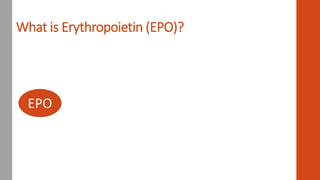Recombinant human erythropoietin
- 1. Development and Clinical use of Recombinant Human Erythropoietin Foundations of Pharmacology November 16, 2017 Gabrielle Clark
- 2. Outline •Introduction • History in Development •Clinical Use • Current work
- 3. EPO What is Erythropoietin (EPO)?
- 4. EPO What is Erythropoietin (EPO)?
- 5. EPO What is Erythropoietin (EPO)?
- 6. EPO To increase erythropoiesis in an attempt to maintain oxygen delivery to vital organs. What is Erythropoietin (EPO)?
- 7. Mechanism of Action • Binds to the erythropoietin receptor: a 72– 78 kDa glycosylated and phosphorylated transmembrane polypeptide. • Member of the superfamily of cytokine receptors. • Binding results in homodimerisation of the receptor, followed by activation of several signal transduction pathways.
- 8. Recombinant Human Erythropoietin Structural and Biological Characteristics Chromosome7q11-22
- 9. Recombinant Human Erythropoietin Structural and Biological Characteristics Chromosome7q11-22
- 10. History of Development •1906 - Carnot and Deflandre Suggested a humoral factor “haemopoietine” to control RBC production Carnot and Deflandre . Comptes Rendu Académie Science Paris. 1906;143:384–386. Donor Blood Anemic 20%-40%
- 11. History of Development • 1950 – Erslev- Provided definite evidence for the existence of EPO and predicted the therapeutic potential of EPO if purified. • 1954 – Hodgson and Toha- First to demonstrate EPO activity in urine. • 1957 – Jacobson et al- First to support EPO production of renal origin. • 1961 – Kuratowsha et al- Confirmed kidney as a source of EPO production. • 1968 – Katz et al -Confirmed liver as another source of EPO production.
- 12. History of Development • 1977- Miyake et al were the first to isolate and purify EPO from urine in patients with aplastic anaemia. Miyake T, Kung CK, Goldwasser EJ. Biol Chem. 1977, 252(15):5558-64. Fig.1. SDS –polyacrylamide electrophoretic analysis of the most active fraction from each step in the purification of human erythropoitien. Ion exchange chromatography Ethanol precipitation Gel filtration Adsorption chromatography
- 13. History of Development • 1985-Jacob et al and Lin et al cloned the human erythropoietin gene and express this gene in mammalian cell. IMPORTANT: Paved the way for industrial manufacturing of recombinant EPO allowing sufficient quantity of EPO for clinical use Jacob et al. Nature.1985 Feb 28-Mar 6;313(6005):806-10. Lin et al. Proc Natl Acad Sci U S A. 1985 Nov;82(22):7580-4. Fig.2. Restriction map of the humanEpo gene. ExonsI-V are indicated by boxes. The solid boxes denote the regions of the exons that are translated.
- 14. History of Development • 1989- FDA approves recombinant EPO for use in chronic renal patients on dialysis
- 15. Clinical Applications Replacement therapy (low endogenous erythropoietin level) in anemia associated with: • Chronic renal failure • Malignancy • Prematurity • HIV infection
- 16. Clinical Applications Supportive therapy to maintain/accelerate erythropoiesis in: • Post-chemotherapy/post-radiotherapy • Post-bone marrow/stem cell transplantation
- 17. Clinical Applications Augmentative therapy to increase haemoglobin above physiological level in: • Surgery • Sports
- 18. Current work
- 19. Thank You
Editor's Notes
- #4: The human body generates 2.5 million new red blood cells (RBCs) per second from the bone marrow to replenish the continuous removal of effete RBCs. The production of RBCs (erythropoiesis) is controlled by an intricate interaction between various humoral factors and cytokines.A specific cytokine, a sialoglycoprotein known as erythropoietin,which acts directly on certain RBC progenitors and precursors in the bone marrow, controls the proliferation, differentiation, and maturation of RBCs. The
- #5: he human body generates 2.5 million new red blood cells (RBCs) per second from the bone marrow to replenish the continuous removal of effete RBCs. The production of RBCs (erythropoiesis) is controlled by an intricate interaction between various humoral factors and cytokines.A specific cytokine, a sialoglycoprotein known as erythropoietin,which acts directly on certain RBC progenitors and precursors in the bone marrow, controls the proliferation, differentiation, and maturation of RBCs. The
- #6: he human body generates 2.5 million new red blood cells (RBCs) per second from the bone marrow to replenish the continuous removal of effete RBCs. The production of RBCs (erythropoiesis) is controlled by an intricate interaction between various humoral factors and cytokines.A specific cytokine, a sialoglycoprotein known as erythropoietin,which acts directly on certain RBC progenitors and precursors in the bone marrow, controls the proliferation, differentiation, and maturation of RBCs. The
- #7: \
- #11: Experiment on injected blood from anaemic rabbits to donor rabbits causing a 20%–40% increased RBC in blood
- #12: http://physrev.physiology.org.libproxy.tulane.edu:2048/content/physrev/72/2/449.full.pdf
- #13: Purification of human erythropoietin.Miyake T, Kung CK, Goldwasser E J Biol Chem. 1977 Aug 10; 252(15):5558-64.


















